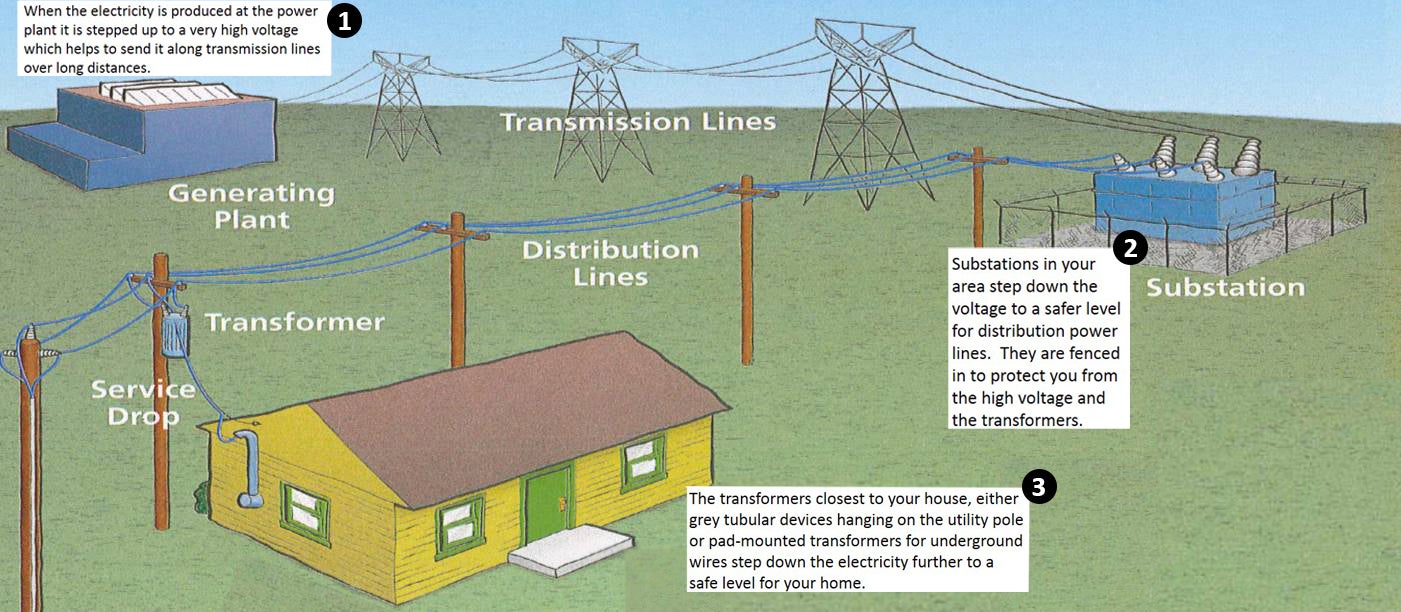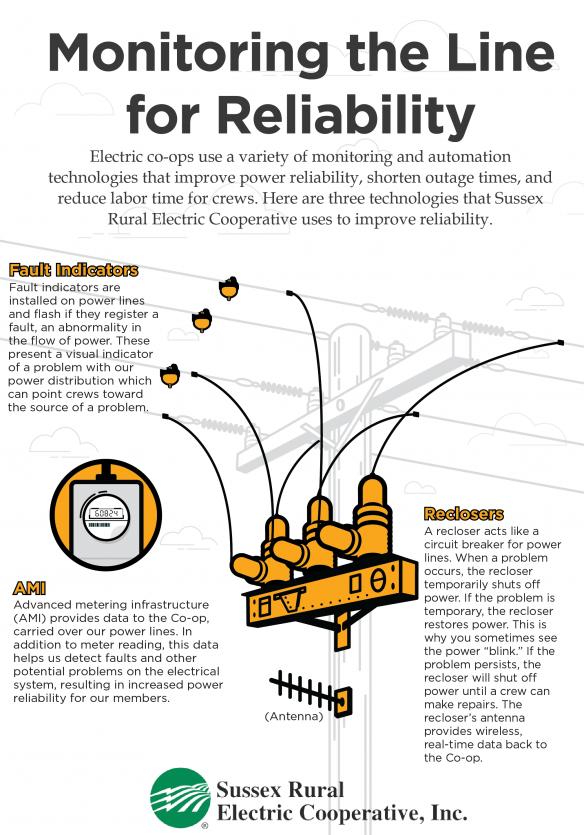Why does SREC share transmission lines with JCP&L?/Why does SREC get its power from JCP&L?
While SREC does not buy its power from JCP&L, we are physically connected to the grid through them. The power we buy is through Allegheny Electric Cooperative in Harrisburg, PA and we joined with the 13 cooperatives in Pennsylvania to form Allegheny in 1937. We currently have two connection (delivery) points and a tie-point between them. We do have way to remotely switch between the feeds, depending on what else might be happening on our own lines.
How are outages classified on the outage map? Why is the number of total outages less than the number of members out?
The "Total Outages" value is not a measurement of the amount of homes without power. Each one of these outages is an issue on our system - whether it's downed lines, a broken pole, a blown transformer, or some other issue. These issues interrupt the flow of power to members' homes. Each individual outage can end up affecting a different number of members depending on the location of the outage. This is why it is important to consider both the "Total Outages" and "Out Now" values to fully understand the scope of an ongoing outage.
Why does the outage map show that a crew has been assigned to the outage when there are no crews on site? Why haven't I seen any SREC trucks in my area?
 When a crew is assigned from our operations center to an outage, our outage map displays a marker of a lineman's silhouette to indicate that a crew has been assigned. This marker will be visible at the location of the outage, and will have the number of meters out of power noted on it. Gathering the necessary materials for the job and arriving at the scene of the problem can take time, so the crew may not arrive immediately after the outage is marked as "Crew Assigned." Additionally, the cause of an outage may be outside the area that's affected, so the assigned crew may not need to go to the residential areas affected by the power outage. This is why you may not see any of our crews in your area during an outage - they are working in another location that feeds power to your neighborhood.
When a crew is assigned from our operations center to an outage, our outage map displays a marker of a lineman's silhouette to indicate that a crew has been assigned. This marker will be visible at the location of the outage, and will have the number of meters out of power noted on it. Gathering the necessary materials for the job and arriving at the scene of the problem can take time, so the crew may not arrive immediately after the outage is marked as "Crew Assigned." Additionally, the cause of an outage may be outside the area that's affected, so the assigned crew may not need to go to the residential areas affected by the power outage. This is why you may not see any of our crews in your area during an outage - they are working in another location that feeds power to your neighborhood.
Why don't you have all your crews out working when the outage map shows multiple outages?
If there is a major delivery point or transmission outage and an entire substation of ours is without power, our outage map will display each distribution circuit out of the substation as a separate outage, even though it really is one single outage. Most of our substations have three circuits, so a substation that is out of power will show three separate color-coded areas as outages. This is just the way our engineering model and map are designed, and how it translates into our outage map. For example, when our Vernon delivery point lost power, our outage map displayed this as 10 separate outages even though it technically was just a single, large outage. However, we only needed a couple of crews to patrol and find the single tree that was the cause, restoring all outages together.
Why does SREC not keep crews on site 24/7, ready to go?
This is both a cost and practicality issue. It would require more personnel, more trucks, and more buildings if we were to keep people on site and working on a 24/7 cycle and ready to go in certain locations. Even just trying to dispatch crews into the field ahead of a storm could either put them in danger or prove to be unnecessary (and not cost-effective at all) as not all weather forecasts are perfect. SREC does, however, put additional crews on standby or, depending on the timing of the storm, keep them at the office in anticipation of a severe storm.
How do the crews work "around the clock?"
In the "good old days," linemen used to literally work 24-hour shifts, and many time longer than that, during storm restorations. This had proven to be a very unsafe practice - they are working in dangerous conditions with dangerous equipment. They are also driving large trucks on public roads, potentially exhausted. All linemen have CDL's (commercial driver's licenses) that are regulated by the Federal Department of Transportation. CDL regulations and other best practice safety rules now help keep linemen, and the public, safer. They can work 16-hour shifts and then get a mandatory 8-hour rest break before returning to work again. When in "around the clock" mode for outage restoration, the cooperative tries to schedule the majority of shifts to be in the daylight hours - when work can be most productive and safest. However, we do keep some crews working overnight when others are on their rest breaks. Thus, the cooperative can work "around the clock" to restore power.
Why is my area always the last to be restored? Why is power not restored on a first-out, first-on basis?
We focus on restoration of large sections first. For instance, we have to put a substations back in service that provides power to several hundred customers before having the capability to energize any individual services. The focus on the large pieces first get the most members back in service the fastest. From here, we focus on progressively smaller restoration efforts. The final stage is restoration of single services. We also can't restore power to locations further down the line without first restoring power to those areas closer to the power source.
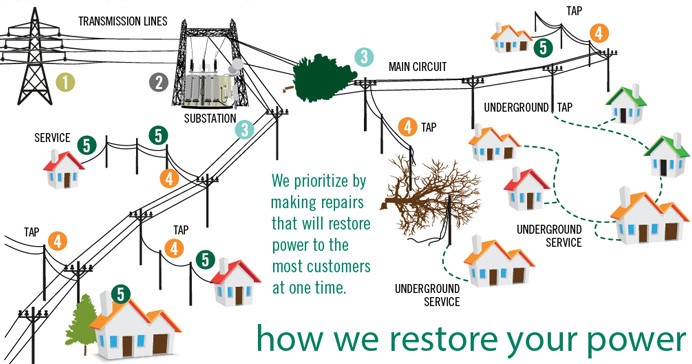
Why don't we get bill credits for outages?
When power is out you do not get charged for power, as your monthly bill is only based on your electricity usage. If you have no power, you use no power, therefore you are not billed for any power. There is nothing to credit. As much as we'd like to, we cannot guarantee electricity to be 100% available and cannot compensate for power outages caused by anything out of our control, such as storms, car accidents, animals, etc.
Why doesn't SREC put its power lines underground?
Excavating trenches and drilling into rock to lay down wires underground in conduit is a very expensive and time consuming, especially when there is already an overhead network in place. Our mission is to provide the highest quality of service for the lowest possible price. Transitioning to underground would be a very expensive process and, as a not-for-profit cooperative, this cost would ultimately fall on our members.
While overhead lines are more susceptible to extreme weather, they are very reliable for most of the year and in cases of damage, they can be repaired easily. When there is a fault on the line, finding and fixing the problem on an overhead system is a lot faster. It is harder and takes much longer to pinpoint the exact location of the fault when wires are below ground which can make repairs more complicated, resulting in longer outage times and increased labor costs. While underground faults typically are less frequent and not as susceptible to weather, unless an entire system is underground there would still be overhead vulnerabilities. New residential developments typically do have their lines installed underground.
Why don't we make the poles taller than the trees?
Most distribution line poles are between 35-40 feet tall, with a small amount of 60-70 foot transmission line poles in some areas. Throughout our service territory, we have trees that are easily taller than that. Installing an even taller overhead system would require massive line trucks with 70' or 80' buckets. Navigating through all of our lake communities and narrow residential roads would be very difficult. Some equipment that linemen use from the ground would not be feasible.
Why do you have to cut my trees?
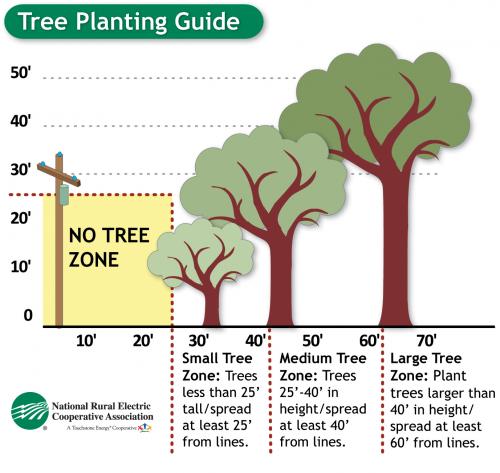 Sussex Rural Electric Cooperative continually strives to provide the highest level of service quality. This service level is defined by minimal interruptions and blinks, proper voltage, and overall reliability. Trees and vegetation are the single largest "culprits" when it comes to service interruptions. As a result, we are continuously trimming the right-of-ways to keep tree limbs away from our power lines. We have a contract with Asphlund Tree Experts, LLC to trim these rights-of-way.
Sussex Rural Electric Cooperative continually strives to provide the highest level of service quality. This service level is defined by minimal interruptions and blinks, proper voltage, and overall reliability. Trees and vegetation are the single largest "culprits" when it comes to service interruptions. As a result, we are continuously trimming the right-of-ways to keep tree limbs away from our power lines. We have a contract with Asphlund Tree Experts, LLC to trim these rights-of-way.
These contractors will concentrate in select areas, trimming our entire service territory over the course of four years, and do as-needed trimming in other areas. Our policy when trimming trees (outside of emergency situations) is to cut and remove everything we cut. Landowners will ask for us to leave the wood for their own purposes from time to time. If you see wood laying around in the wake of our crews trimming, this is most likely the reason. This work will benefit you with fewer interruptions and blinks, and will improve your overall quality of service.
When planting trees, remember to take into consideration future growth (see the Tree Planting Guide). For more information on our policy on residential trees, please read out Tree Management page.
Why doesn't SREC cut more trees?
We maintain 10-25 foot clearances on either side of the power lines, along with 15 feet above them, depending on the line voltage (distribution or transmission). However, during an ice storm or a snowstorm with heavy, wet snow, a weighted tree can bend over or fall over, touching the lines from as far as 40-50 feet away. Additionally, in a wind storm a branch can be blown from nowhere near our right-of-way to land on the lines.
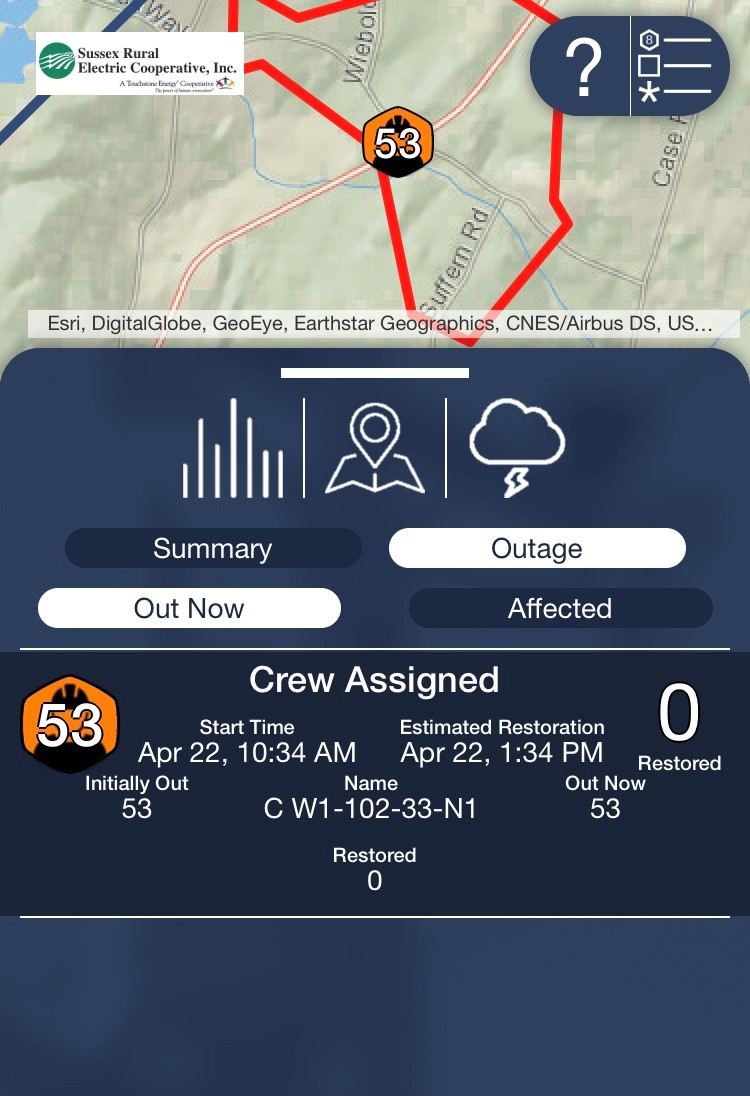 How are estimated restoral times determined?
How are estimated restoral times determined?
We estimate restoral times in a variety of ways. Initially it is mostly computer generated. An estimated time factors in the time it takes the crew to get to the office (if after hours), do their safety checks on trucks, drive to the outage (which can be 30+ minutes from our yard), and assess the situation. It also includes time to account for what the reported outage includes. For example, if there is a car accident and the pole is broken, the crew will have to bring a pole with them and, depending on the height of that pole, they may need more crew members than standard. Every situation is different, and every outage is a new potential danger. We estimate the time for all of this and then amend the time if the situation changes or repairs are taking longer. The outage map should not be taken as fact, it is an estimated time of restoral.
How do you plan to avoid major outages in the future?
Sussex Rural Electric's mission is to provide the highest quality of service at the lowest possible cost. In some years, this can be a tough battle. When you live in a rural area as we do, weather and vegetation often conspire to interfere with our constant flow of electricity. From the flicker of a momentary interruption when a tree limb hits a wire to the complete outage from ice bringing down lines completely, weather and vegetation have a definite impact on power reliability. While we cannot control Mother Nature, we can learn from each outage and work as efficiently and safely as we can to keep the outages to a minimum. We have advanced our technology in the past decade to go from a manual outage management system to an automated one, and we will continue to utilize new technology as it is developed within the industry. We have integrated many separate computer systems and continue to improve those integrations so that they work even more seamlessly, bridging together customer and engineering systems and data. We have increased our tree trimming cycle so that we trim all 700+ miles of our lines every four years, up from a five year cycle in the past. We have also increased our vegetation management budget to account for and remove "danger trees" - trees that are dead or dying and outside of the regular right-of-way, but that could still fall on our lines.
Why can't you tell me how long my power will be out?
If the outage is extensive with significant damage to our system, we cannot always tell what has been damaged until we begin to restore power. A connection that appears to be fine may, in fact, be damaged and will not show up until the lines to it are fixed and energized. We try to provide estimates of restoration time whenever possible via the radio, television, social media, or through our voluntary email alerts.
Why do I need to call? Don't you know right away when my power is out?
Our automatic metering system reports kWh use to us, but because this is a delay in this reporting we will not know immediately if your power is out. We will eventually receive information showing your power is out, but this may take some time. Calling our office when your power goes out is the best way to have us address the problem more quickly.
Additionally, an outage caused by something inside your home or business will not be reported to us by our metering system since our flow of power to the electric meter is still there. If you lose power, check to be sure your breakers haven't tripped. If they are fine, give us a call and we will try to determine the source of your outage.
There was a big storm with lots of people losing power. It seems like mine has been out longer. What do I do?
In large storms, damage hits all parts of our system. Our crews work to restore the largest number of customers and critical-need customers first then work their way through all the damage. Sometimes, the power line leading to your home has been damaged and we simply have not seen it. Here's a simple test: check your breakers to be sure they are all set properly, then check with your neighbors on both sides to see if they have power. If your breakers are fine and your neighbors have power, call us and we will get our crews to help you.
In the meantime:
- Have a flashlight and battery-operated radio handy. Be sure to have extra batteries on hand.
- Have a hardwired phone (one without a power pack) or a fully charged cell phone for emergency calls.
- Make sure you know how to exit your garage if it has a powered opener. Most have a red handle to pull that releases the mechanism so you can raise the door by-hand. Check it in advance.
- Stockpile water and a small supply of nonperishable food.
- Check any emergency generator for proper orientation.
- Have a list of important phone numbers handy (family members, friends, a doctor, etc.). Keep it with your storm kit.
- Make sure you have an adequate supply of medications. If the medications require an electrically-operated device to administer, be sure you have a backup power supply or a mechanical alternative. We cannot ensure when we will be able to restore power so you must take steps to be sure you can administer important medications when needed.
During an outage I had to throw away all the food in my refrigerator. Will the Co-op reimburse me?
Like most utilities, Sussex Rural Electric Cooperative does not cover the loss of food during an outage. This applies during any outage when a storm was an act of nature, not a fault of any one person or entity.
Damage or loss from power outages is ordinarily covered under your homeowner's policy if the power outage occurs on your property and is not general and widespread. However, insurance coverage for food loss during power outages can vary among providers. Your reimbursement for loss of food in a power outage depends on your actual coverage. Because so many variables depend on your individual carrier and policy, don't make any assumptions about your power outage coverage. Read your policy carefully to see if food spoilage is specifically excluded within your list of exclusions. If you're still uncertain about whether or not you are covered, contact your insurance agent and ask him or her to explain your protections.
Where does my power come from?
What is all the equipment attached to my house? Do I own this?
Your Cooperative distributes power to you and other members across utility poles and transformers that are owned and maintained by the Cooperative. Once specialized wires, known as a service drop, come off of a residential pole-mounted transformer and descend to your home's weatherhead, which leads to your electric meter, this is the point of transition where you own the equipment. This excludes the meter, which is the Cooperative's responsibility.
We've produced a special whiteboard animated video in our Watts It About? series to help illustrate this. Watch below!
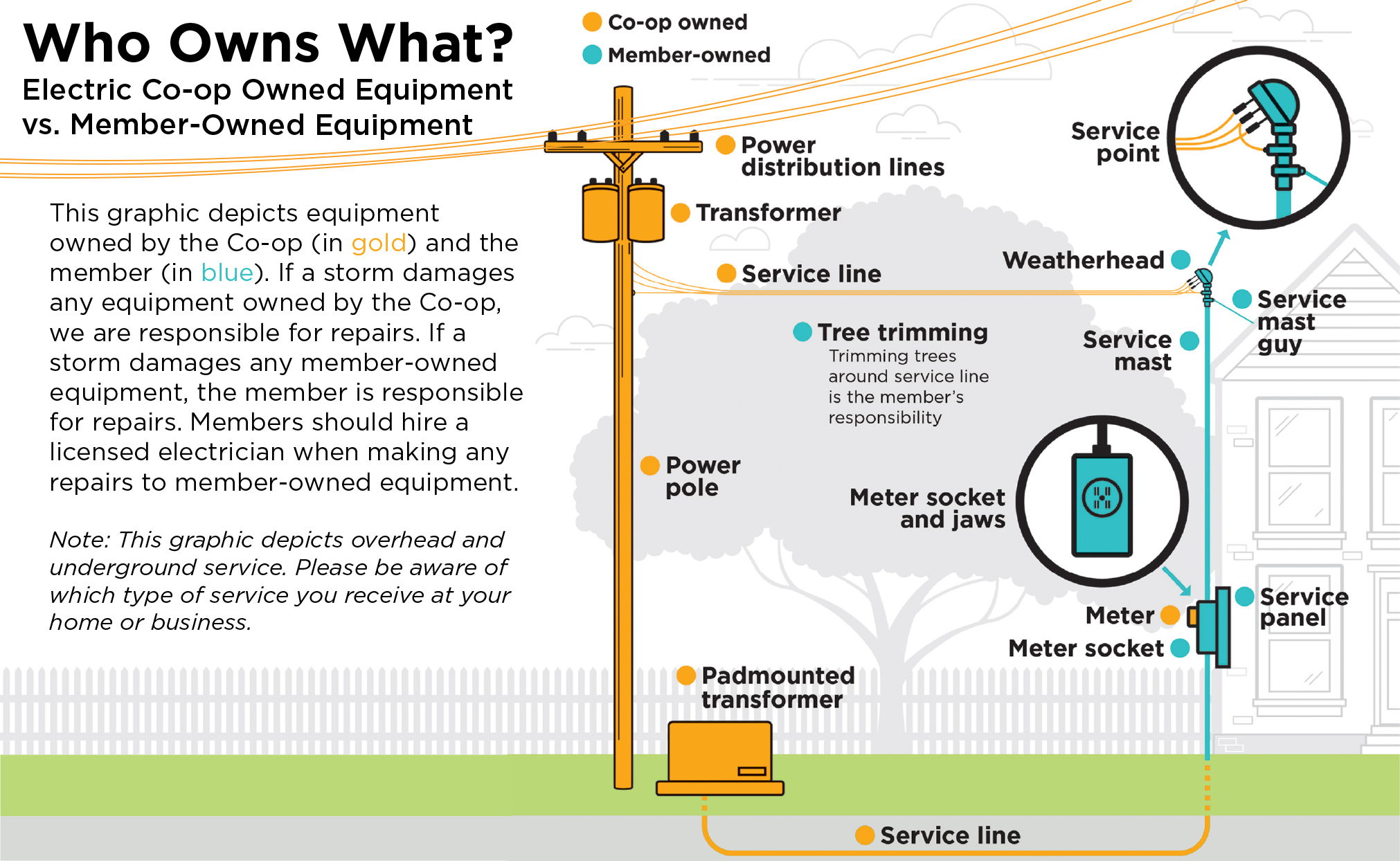
When having work done on my home, can an electrician pull my electric meter or should the Co-op?
Your Cooperative must insist that members having work done on their home call our office at 973-875-5101 to schedule a Co-op employee come to perform disconnect service rather than hiring a third-party electrician. This is for the safety of all involved, as electrical problems could arise if the electric meter is not rewired properly. We offer disconnect and reconnect services absolutely free of charge.
What does all the equipment on the utility pole do?
Why are there SREC flags on my property?
If there are SREC flags on your property, there is usually a markout request required. This does not mean that Sussex Rural Electric Cooperative has worked scheduled on your property. Instead, this usually indicated that you have requested work from a contractor (usually a pool or fence install, septic work, etc.) which may be impacted by underground power lines.
When this is the case, you should call 811, the national "Call Before You Dig" hotline. This service will be able to provide you with the information you need to safely proceed with your project. New Jersey's 8-1-1 affiliated website, www.nj1-call.org, includes detailed information on what each flag color indicates and will allow you to inquire about existing markings.
For information on Sussex Rural Electric Cooperative's current rates, please visit our Rates page
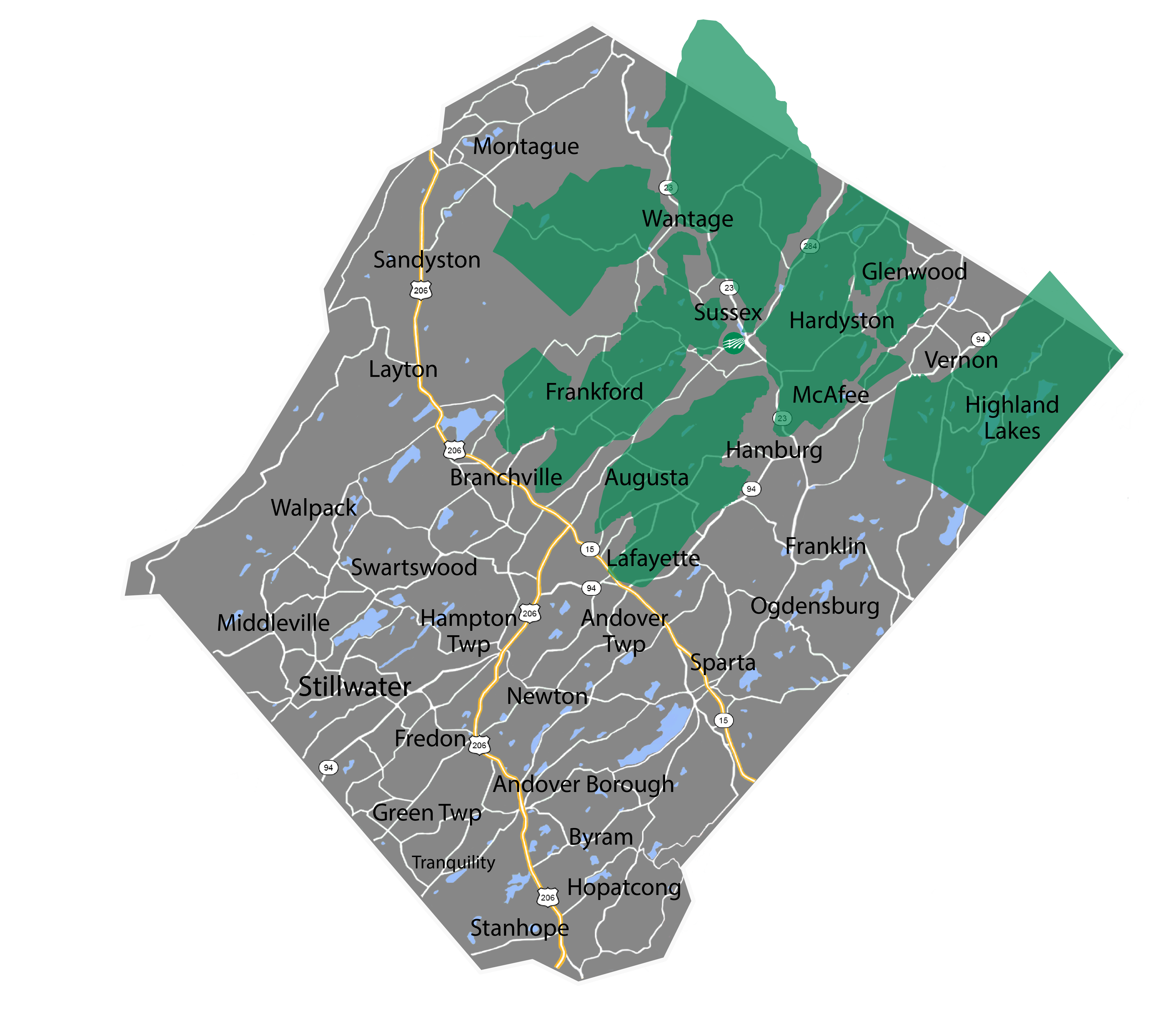 How do I sign up for service? How can I cancel?
How do I sign up for service? How can I cancel?
Sussex Rural Electric provides power to homes and businesses in portions of Augusta, Barry Lakes, Frankford Township, Hardyston, Highland Lakes, Lafayette, Vernon, and Wantage, as well as a small portion of Orange County, NY. When you move into our service territory, you must sign up for service with us to receive power.
Signing up for service is simple and easy. It can be done in one of three ways:
- You may apply online here
- You may call our office at 973-875-5101 and request to receive an application by mail
- You may download an application here
Upon completion of the form, you can bring it by the office or mail it to us. If you submit your application by mail, you must return the application with all of your deposit and membership fees before your service can be connected. A signed Right-of-Way may also be required.
A $5 membership fee is required for new members of the Cooperative, the same amount our original members paid to opt in to service in the 1930s. The need for any other form of deposit is determined on a case-by-case basis using a nationwide, utility-oriented third party service that advises us with recommendations based on data from financial and other institutions.
If you are moving out of our service territory or must cancel your service for any other reason, you may call our office at 973-875-5101 and request cancellation. Alternatively, you can access an online disconnect form here. Information on further steps to terminating service can be found on our Moving Out page.
How do I add or delete a name on my account?
An account can have up to two names on it. Names can be added or removed when both parties fill out a form (for the name addition form click here and for the name removal form click here). Once filled out, this form should be brought to our office to be processed. To have a name removed, the account in question must have a zero balance.
If you want to transfer ownership of the account to another name, you must call our office and arrange to pay $5 as a membership fee to open a new account. The original $5 membership paid at the start of service will be refunded to the original account holder.
What are my payment options for my bill?
You can choose to pay your bill in several ways:
- Online payment - one time or recurring (recurring payments via bank account have no credit card convenience fee applied)
- Quick pay allows you to securely pay your bill online without needing to log in to an account
- Dropping off a check or cash at our office's front counter - 64 County Route 639, Sussex, NJ 07461 (Mon-Fri, 8:00 AM - 4:30 PM)
- Using our office's dropbox for secure payments after hours
- Visa, MasterCard, or Discover via phone/online; (NOTE: your credit company will charge a 3.65% convenience fee, $1.95 minimum)
- Members can also pay by check over the phone with no fee applied
What is the System Connection Fee?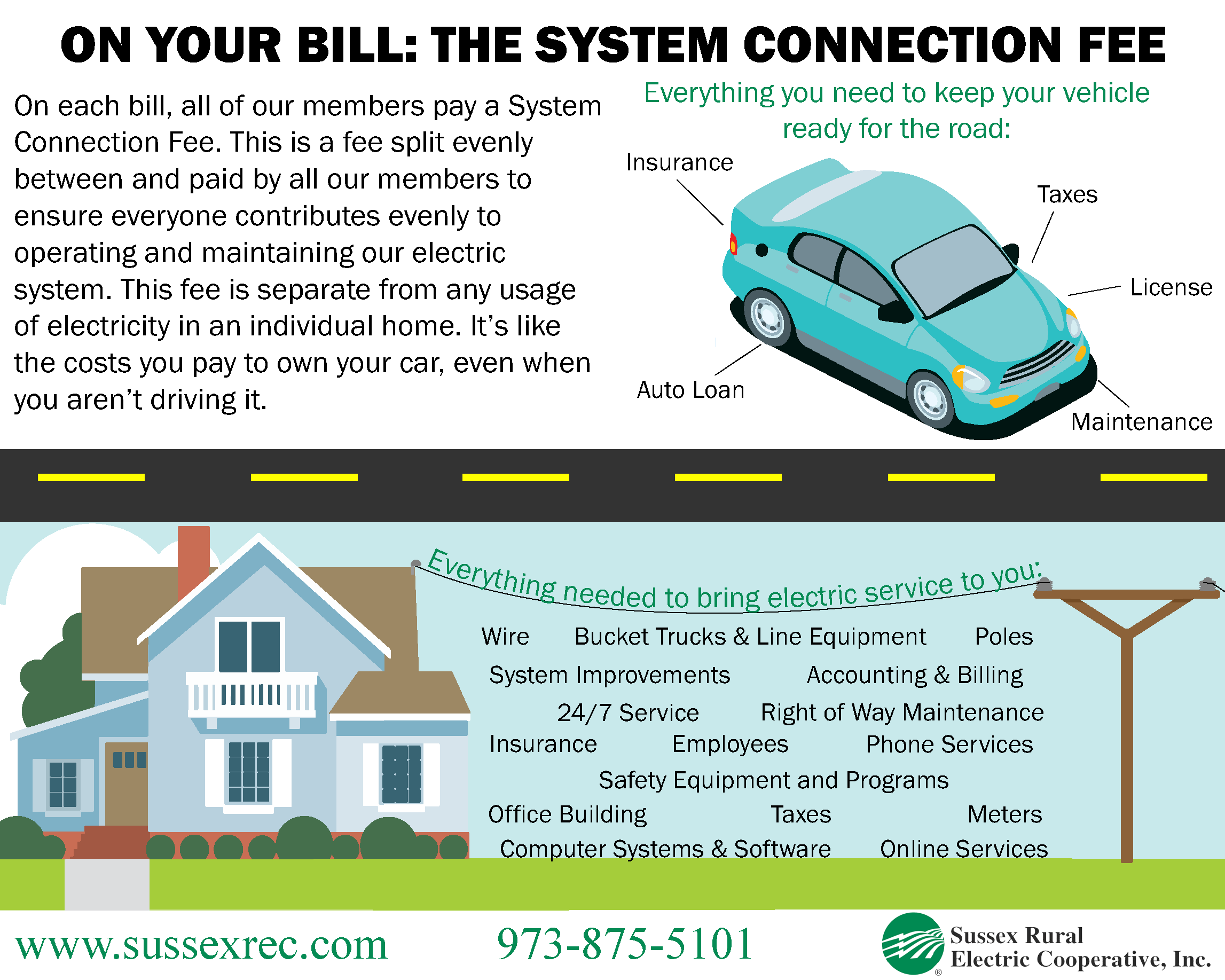
The System Connection Fee (formerly known as the Facilities Charge prior to 2019) is a fixed rate on your monthly bill used by the Co-op to cover the expenses of maintaining the best possible quality of electric service by investing in improvements to our equipment and infrastructure. Quite literally, it is the fee each member pays to maintain a reliable connection to our system. Every member pays the same amount each month, regardless of kWh (kilowatt hour) use. This fee covers costs that would exist regardless of whether each member used 100 or 1,000 kWh for the month, so the Cooperative charges everyone equally to ensure power can keep flowing reliably through the community.
Below are examples of expense items covered by the System Connection Fee:
- Wire, transformers, utility poles, other equipment, and labor needed to build and maintain our electric distribution system
- Keeping pace with increased system investments to improve both capacity and reliability
- Implementing new technologies to provide increase reliability and operational efficiencies such as the outage management system and advanced metering
- Liability insurance, interest, taxes, and emergency storm restoration
- Outage restoration costs
For more information on this and other charges, view this graphic, or visit the Rates and Fees page and the Understanding Your Bill page.
I prefer to pay my bill online through my bank. Does SREC accept this payment method?
Sussex Rural Electric Cooperative does accept online payment through members' banks to pay their bills. However, depending on your bank SREC's name may not appear in the dropdown optiosn unless "Sussex Rural Electric Cooperative" is spelled out in full. This is the case for PNC Bank customers and potentially other banks. Please be sure to always spell out "Sussex Rural Electric Cooperative" in full when paying your bill online through your bank.
Why did I get a check in the mail? What are "capital credits?"
Our members can think of capital credits as their "refund" for paying into the operation of their Co-op. Because Sussex Rural Electric Cooperative is a not-for-profit company, members' electric bills go towards the purchase of electricity for distribution and covering the costs of operation. Surplus revenue beyond this is saved for emergencies and reinvested into the Co-op's operations, but every individual member's contribution to this surplus is tracked carefully. The board of directors eventually votes on when it's feasible to "retire" these funds for individual years of service, sending members back their share of money based on what they contributed that year in the form of capital credits.
Because capital credits are tracked and delivered by year, it is important for our members to provide us with a new address if they move out of our service territory so we can continue to send members checked when funds are retired for years they lived on our lines. Capital credits are not necessarily retired on a yearly basis. For more information on exactly how capital credits work, visit our Capital Credits page.
What is an electric cooperative?
Electric cooperatives are not-for-profit businesses that are founded, owned, and governed by local members like yourself. There are electric co-ops in rural communities throughout the country, but no two co-ops are alike because each is shaped by the individual communities that built them. Sussex Rural Electric Cooperative is the only electric cooperative in New Jersey and the most technologically advanced electric utility in the state.
Electric Cooperative Statistics 
There are currently over 900 electric cooperatives in the United States. These co-ops serve:
- 42 million people across 47 states
- 19 million businesses, homes, schools, churches, farms, irrigation systems, and other establishments in 2,500 of 3,141 counties in the U.S. (88% of the nation's counties!)
- 12% of the nation's population
- 56% of the nation's landmass
- An average of 8 customers per mile of electric line compared to the average 32 customers per mile that Investor Owned Utilities serve
To perform their mission, electric cooperatives:
- Own assets worth $92 billion
- Own and maintain 2.4 million miles, or 43%, of the nation's electric distribution lines, covering three quarters of the nation's landmass
- Deliver 10% of the total kilowatt hours sold in the U.S. each year
- Generate nearly 5% of the total electricity produced in the U.S. each year
- Employ 65,000 people in the United States
- Pat more than $1 billion in state and local taxes
The National Rural Electric Cooperative Association (NRECA) represents the national interests of cooperative electric utilities. NRECA provides legislative, legal, and regulatory services, and programs in insurance, management and employee education, training, consulting, public relations, and advertising. NRECA and its member cooperatives also support energy and environmental research and administer a program of technical advice and assistance in developing countries around the world through its partner organization NRECA International.
Why do you call your customers "members?"
Cooperatives like Sussex Rural Electric operate under a different business model than traditional Investor Owned Utilities and other businesses. Electric co-ops were first established in the 1930s to bring electric power to rural areas which large electric companies ignored because they saw no opportunity for profit. To fir this need, electric cooperative were organized by individuals within these communities and set up as nonprofit organizations without investors to please or profit margins to meet. Instead, electric cooperatives focus on satisfying the needs of those in their community.
You are a member-owner of your co-op because your payments are what keeps the co-op running, you have democratic influence over the Co-op through your right to vote and run in our elections for our board of directors, and you are refunded excess revenue in proportion to what you paid into the Co-op during a given year (see the capital credits question below).
While we charge for the cost of service and must implement fees that allow us to maintain our equipment and facilities, this is different from the traditional relationship between Investor Owned Utilities and their customers because we do not seek to make a profit, only to ensure our members continue to receive the highest quality of service at the lowest possible price.
To learn more about what Co-op membership means, check out our Membership Information page.
What are capital credits? How do they work?
As a not-for-profit utility owned by our members, any margins that the Cooperative makes are eventually returned directly to our member-owners in the form of capital credit payments. Here's how they work:
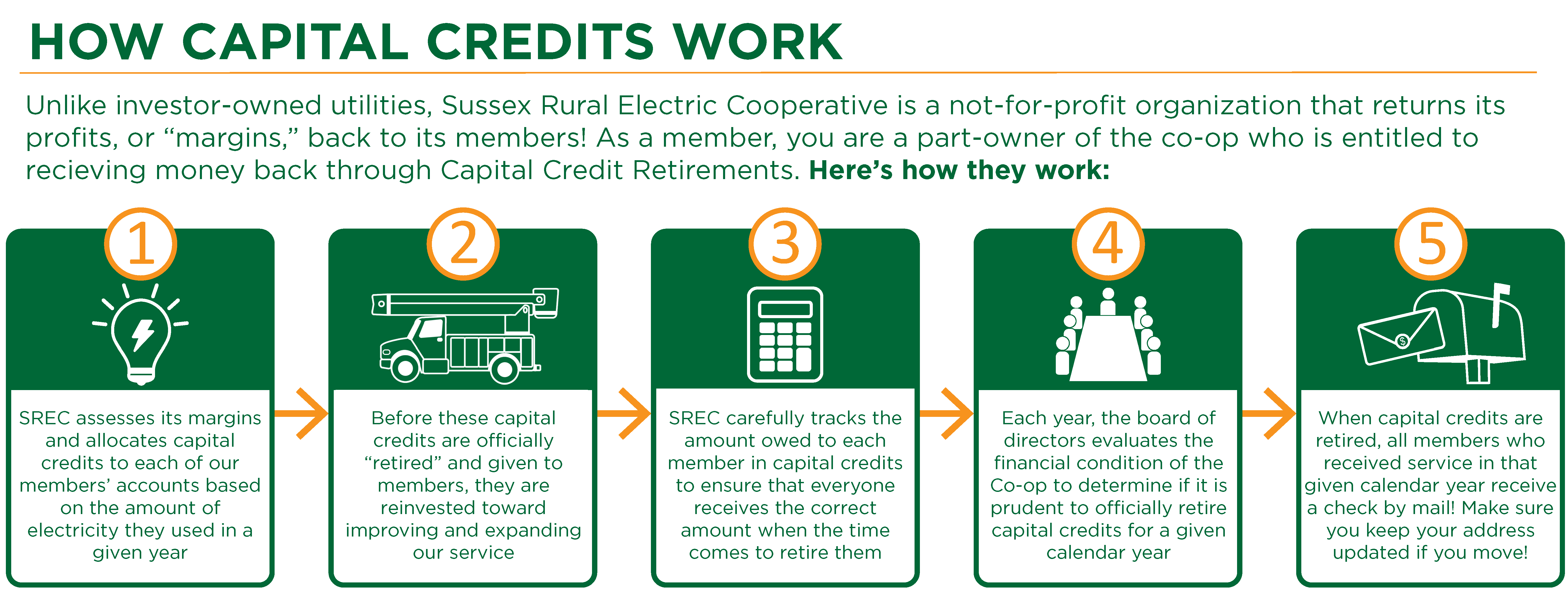
For more information on capital credits, check here. If you or someone you know has moved out of our system and may not have received capital credit retirements owed to them, check our List of Unclaimed Capital Credits.

